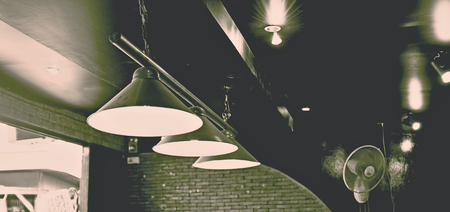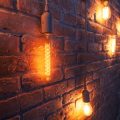Understanding Edwardian Lighting Aesthetics
To embark on the journey of restoring original lighting fixtures in Edwardian houses, it is essential first to grasp the unique visual language and cultural context that defined lighting in this era. The Edwardian period, spanning from 1901 to 1910 (and often extending into the early 1920s in terms of design), marked a distinct transition in British domestic interiors. Influenced by both the sinuous lines of Art Nouveau and the honest craftsmanship of the Arts and Crafts movement, Edwardian lighting fixtures reflected a harmonious blend of decorative artistry and functional innovation.
The Influence of Art Nouveau and Arts and Crafts Movements
Edwardian lighting borrowed the organic motifs and fluid forms characteristic of Art Nouveau—think delicate floral patterns, curved stems, and nature-inspired glass shades. Simultaneously, the Arts and Crafts ethos championed hand-crafted metalwork, geometric simplicity, and a return to traditional materials such as brass, copper, and wrought iron. These influences resulted in fixtures that balanced refined elegance with understated charm—a departure from the heavy ornamentation of the preceding Victorian era.
Social Change Meets Technological Progress
The dawn of the 20th century was a time of rapid social change in Britain. The rise of the middle class and evolving attitudes towards domestic life brought about brighter, more open interiors. Technological advancements also played a pivotal role: gas lighting was gradually giving way to electricity, making possible new forms and configurations for light fittings. Ceiling pendants with opaline glass shades, wall-mounted sconces with pull cords, and intricate lanterns became hallmarks of Edwardian homes.
Defining Features of Edwardian Lighting
In summary, Edwardian lighting is distinguished by its graceful lines, subtle use of ornamentation, quality materials, and adaptability to emerging technologies. Understanding these characteristics provides crucial insight for anyone seeking to authentically restore or sympathetically reproduce original lighting features within an Edwardian property. By appreciating this rich aesthetic heritage, homeowners can illuminate their spaces with both historical accuracy and timeless style.
2. Identifying Original Fixtures and Assessing Condition
When embarking on the restoration of Edwardian houses, the first crucial step is to distinguish genuine period lighting from later additions or reproductions. Edwardian lighting fixtures are celebrated for their blend of late Victorian opulence and emerging modern sensibilities, often featuring elegant lines and delicate ornamentation. The most common original fittings include pendant lights suspended from ornate ceiling roses, gasoliers (dual-function gas and electric chandeliers), and wall sconces with decorative brass or bronze mounts.
Recognising Authentic Edwardian Light Fittings
| Type | Key Features | Common Materials |
|---|---|---|
| Pendant Lights | Simple glass shades, often frosted or etched; chain or rod suspension; detailed metalwork around canopy | Brass, bronze, opaline glass |
| Gasoliers | Arms for both gas jets and electric bulbs; intricate central column; sometimes converted entirely to electric | Copper, brass, crystal drops |
| Wall Sconces | Sweeping arms; backplates with floral or geometric motifs; designed for candles or early bulbs | Brass, gilt metal, cut glass |
Practical Tips for Assessing Condition and Authenticity
- Inspect for original maker’s marks—often stamped discreetly on metalwork or inside shade holders.
- Check wiring: Pre-1930s electrical fittings will usually have fabric-wrapped wires, now unsafe but a sign of age.
- Look for patina: A genuine fixture will show subtle signs of wear—such as tarnish on brass or minor surface scratches—that should not be over-cleaned.
- Assess modifications: Many period homes have had fixtures adapted for electricity. Carefully note any visible drill holes or non-original parts that may affect value or integrity.
The Importance of Contextual Research
Before restoration begins, consult local archives or heritage listings to better understand what would have been typical in your property’s original era. Matching styles to architectural details—like cornicing and ceiling heights—will help ensure any retained or replaced fixtures are contextually appropriate. This careful assessment not only preserves authenticity but also upholds the unique character that makes Edwardian homes so cherished in British architectural heritage.
![]()
3. Sourcing Restoration Materials and Components
Securing authentic materials is crucial when restoring Edwardian lighting fixtures, ensuring both historical accuracy and visual harmony. In the UK, there are a wealth of options for sourcing period-appropriate components.
Reclamation Yards
Reclamation yards remain a goldmine for original fittings and parts. Well-established venues such as Lassco in London or The Architectural Forum often carry everything from brass lamp holders to ornate glass shades salvaged from period properties. These yards not only provide genuine materials but also offer expert advice on matching styles and eras.
Antique Fairs and Markets
Attending antique fairs can be invaluable for finding unique pieces, especially those that seldom appear online. Notable events like the Newark International Antiques & Collectors Fair or Kempton Park Antique Market regularly feature dealers specialising in Edwardian architectural salvage. Here, you can inspect items firsthand, verifying patina and craftsmanship before purchase.
Online Dealers Specialising in Architectural Salvage
The digital realm offers access to reputable UK-based suppliers such as The Old Lighting Company and Retroworks. These specialists curate stock with provenance, listing everything from Bakelite switches to period-correct flex cable and reproduction gallery rings. Online platforms like SalvoWeb act as directories, linking seekers with trusted salvage merchants across Britain.
Advice for Ensuring Authenticity
When sourcing parts, always inquire about the item’s origin and compatibility with Edwardian fixtures. Seek out solid brass rather than plated metals, mouth-blown glass, and cotton-wrapped wiring where possible. Consult conservation experts or local craftspeople for guidance on marrying new materials sympathetically with existing fixtures.
Connecting with Restoration Communities
Engaging with restoration forums or local heritage groups can yield insider tips on lesser-known sources and skilled tradespeople adept at refurbishing vintage lighting. This collective knowledge helps ensure your project remains true to the Edwardian spirit while benefiting from contemporary best practice.
4. Restoration Techniques and Safety Considerations
Restoring original Edwardian lighting fixtures is a delicate process that demands both respect for heritage and adherence to modern safety standards. The approach involves meticulous cleaning, expert rewiring, and sensitive repair work—each step guided by the principle of preserving authenticity while ensuring household safety.
Cleaning Original Fixtures
Edwardian fittings often feature intricate glass shades, ornate brass arms, or hand-painted ceramic elements. Cleaning these requires gentle methods to prevent damage:
| Component | Recommended Cleaning Method |
|---|---|
| Glass Shades | Lukewarm water with mild soap; avoid abrasive cloths |
| Brass Fittings | Polish with a soft cloth and non-acidic brass cleaner; avoid over-polishing to retain patina |
| Ceramic Parts | Damp microfibre cloth; steer clear of chemical cleaners |
Rewiring to Meet Current UK Electrical Standards
Original Edwardian wiring rarely meets today’s regulations. For both safety and insurance purposes, fixtures should be rewired using modern cable rated for UK voltage. It is advisable to use heat-resistant flex and ceramic lamp holders, especially in enclosed fittings. All work must adhere to the latest IET Wiring Regulations (BS 7671), which govern domestic electrical installations in the UK.
PAT Testing and Building Regulations Part P
After restoration and rewiring, Portable Appliance Testing (PAT) is essential. This ensures the fixture is safe for use on the UK mains supply. Furthermore, any electrical work carried out within domestic premises must comply with Building Regulations Part P, which mandates that electrical installations are designed and installed to protect people from fire and electric shocks. Always consult a qualified electrician familiar with heritage properties.
Repairing Delicate Components
The fragility of Edwardian glass and ceramics means that repairs should be undertaken with conservation-grade adhesives or by skilled restorers. Brass arms can be reshaped or soldered if necessary but must be handled with care to avoid warping or removing historical finishes.
By blending traditional craftsmanship with contemporary safety practices, you honour the spirit of Edwardian design while creating a secure home environment fit for modern living.
5. Preserving Authenticity while Embracing Modern Living
Integrating restored Edwardian lighting fixtures into contemporary homes is both an art and a balancing act, requiring sensitivity to the original character of the fittings and practical consideration for 21st-century lifestyles. The key lies in preserving authenticity while ensuring that your home remains functional and comfortable.
Discreet LED Retrofits: Blending Old with New
One of the most effective strategies is to retrofit original Edwardian fixtures with modern LED technology. Carefully selected LED bulbs can offer the warm glow characteristic of early 20th-century lighting, while consuming far less energy and generating less heat. Many specialist suppliers offer bulbs designed to mimic the filament look, ensuring visual continuity. Where possible, opt for dimmable LEDs to retain flexibility in ambiance—perfect for those moody Edwardian drawing rooms repurposed as lounges or studies.
Sympathetic Placement: Honouring Period Charm
Restored fixtures should be positioned thoughtfully to highlight architectural features such as cornices, ceiling roses, and ornate mouldings. Rather than overcrowding spaces or forcing modern layouts onto period rooms, allow the lighting to complement existing sightlines and focal points. For example, a grand pendant chandelier works beautifully in a high-ceilinged hallway, while wall sconces can be used to illuminate alcoves or reading nooks without overwhelming the space.
Maintaining Balance: Practicality Meets Preservation
While it’s tempting to keep every detail strictly period-correct, consider integrating subtle modern conveniences. Wireless switching systems or smart lighting controls can often be added unobtrusively behind plasterwork or within existing switch plates, allowing you to enjoy both historical aesthetics and modern ease. In bathrooms or kitchens—areas where additional task lighting may be required—choose fittings with Edwardian-inspired designs, so new additions feel like a natural extension rather than an intrusion.
Ultimately, the aim is not to create a museum piece but a living home that celebrates its heritage. With careful planning and sympathetic updates, you can enjoy the timeless elegance of Edwardian lighting while benefiting from all that modern technology has to offer.
6. Case Studies: Successful Restorations in British Homes
Bringing History Home: A Victorian Villa in Brighton
For Jane and Robert, restoring the original Edwardian pendant lights in their seaside villa was a labour of love. After discovering the fixtures hidden beneath decades of paint and neglect, they worked with a local specialist to gently strip layers and replace delicate glass shades. “It transformed our hallway from a gloomy corridor to a warm, inviting space,” Jane says. The restoration process revealed hand-etched designs and intricate brasswork, offering not just illumination but a daily connection to their home’s heritage.
London Terrace Transformation: From Dull to Dramatic
In North London, Mark and Lisa sought to breathe life back into their terraced house’s original fittings. With professional rewiring and careful polishing, the couple restored several Edwardian ceiling roses and wall sconces. “We always thought about replacing them, but nothing modern compared to the craftsmanship of what we already had,” Mark explains. The result was a subtle grandeur that added authenticity and character to every room—proof that preservation can rival any contemporary renovation.
Testimonial: A Cotswolds Cottage Embraces Its Roots
Sarah, owner of a picturesque cottage in the Cotswolds, recalls her initial doubts about keeping her battered light fittings. “I thought they were beyond saving,” she admits, but after consulting with a lighting restorer, she discovered the value in each original detail. Now, her softly glowing Edwardian lanterns are conversation starters for guests—and have even increased the property’s value. “They’ve become part of our family story,” she shares.
The Transformational Effect on Interiors
Across these homes, restored Edwardian lighting has done more than brighten interiors—it has fostered an appreciation for artistry and tradition. Homeowners consistently mention how the fixtures serve as focal points, tying period features together and elevating everyday living spaces into something truly special.
The Enduring Value of Craftsmanship
These case studies highlight not only the aesthetic rewards but also the sense of stewardship that comes with preserving original lighting. For many UK homeowners, restoring Edwardian fixtures is about honouring skilled makers of the past while ensuring their legacy continues to shine for generations to come.


